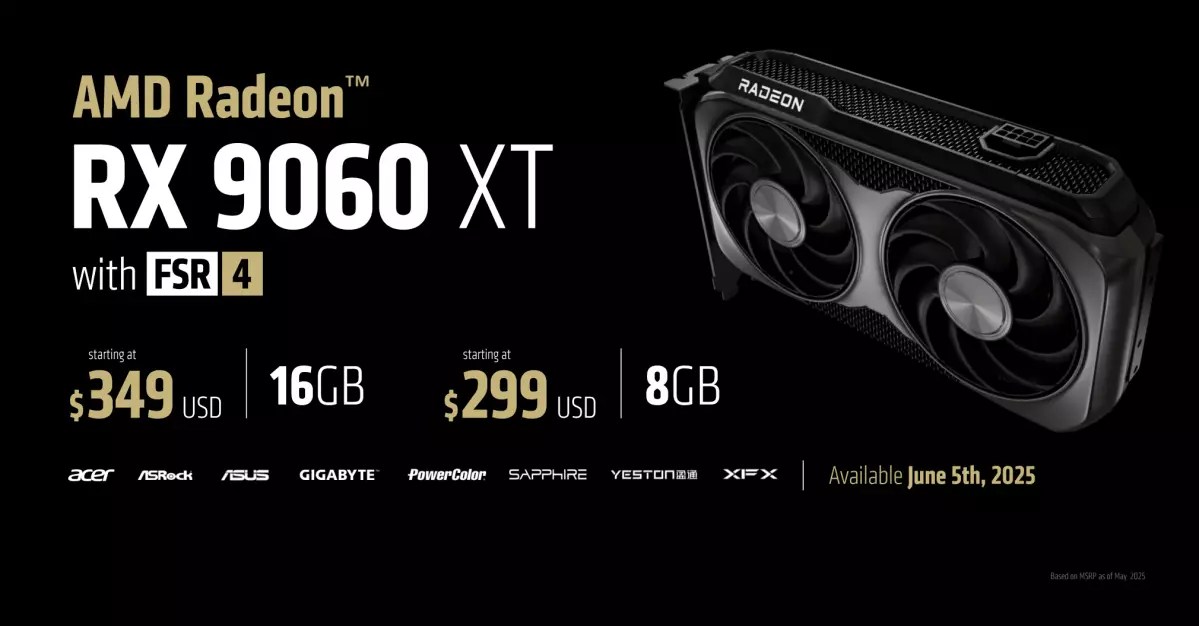In the ever-evolving world of gaming technology, AMD has made a significant announcement that could alter the competitive landscape of graphics processing units (GPUs). At Computex, AMD unveiled its highly anticipated Radeon RX 9060 XT, a GPU set to take on Nvidia’s recently launched RTX 5060 series. This announcement has generated considerable excitement, especially given the increasing demands for performance-driven graphics cards in 2025. However, it’s equally important to note that despite the buzz, specifics regarding pricing and release dates are still shrouded in mystery, which may give consumers pause.
Specifications that Demand Attention
The Radeon RX 9060 XT boasts a formidable architecture, featuring 32 RDNA 4 compute units and a remarkable boost clock speed of 3.13GHz, suggesting that the card is engineered for serious performance. The available models, equipped with either 8GB or 16GB of VRAM, indicate that AMD is poised to cater to both budget-conscious gamers and those seeking high-end performance. Priced at $299 for the 8GB variant and $349 for the 16GB model, AMD is striking a balance between accessibility and high-end gaming requirements. Nonetheless, the decision to offer an 8GB option in an era of increasingly demanding game titles raises eyebrows, particularly considering the growing concerns about memory capacity.
The 8GB VRAM Controversy
The backlash regarding the 8GB VRAM spec has become a focal point in discussions around both AMD and Nvidia GPUs. With modern games frequently requiring more memory to deliver high-quality textures and smoother gameplay, one can’t help but wonder if 8GB is sufficient for the longer term. AMD has opted to mirror Nvidia’s controversial VRAM strategy, and this leaves a considerable question mark over the viability of both companies’ offerings. The upcoming RX 9060 XT is claimed to be approximately 6% faster than Nvidia’s RTX 5060 Ti at 1440p resolution—a tantalizing prospect—but whether that performance is sustainable with just 8GB of VRAM remains to be seen.
Nvidia’s Shadows in the Market
Interestingly, Nvidia’s approach in launching the RTX 5060 without any prior reviews paints a perplexing picture of technology marketing strategies. By seemingly limiting reviewers’ access, Nvidia is attempting to manage the narrative surrounding its newest offerings, perhaps out of apprehension about the 8GB VRAM issue. It’s a gamble that can either pay off spectacularly or backfire, especially in a community as vocal and passionate as that of PC gamers. Meanwhile, rumors about Nvidia pressuring content creators to showcase features like Multi Frame Generation (MFG) raise additional eyebrows about transparency and competitive ethics in the industry, adding yet another layer of complexity to the competitive dynamics.
The Road Ahead: Implications for Gamers and AMD
For the average gamer, the upcoming Radeon RX 9060 XT presents a blend of hope and apprehension. On one hand, AMD is demonstrating its commitment to innovation and competition in a GPU market dominated by Nvidia. On the other hand, the lack of clarity regarding pricing and release date, coupled with the 8GB VRAM concern, casts a shadow over these advancements. Although AMD claims its offering will outperform parts of Nvidia’s lineup, the success of the RX 9060 XT will heavily hinge on actual performance benchmarks and real-world gaming scenarios.
As we move closer to the RX 9060 XT’s launch, the spotlight will undoubtedly remain fixed on both AMD and Nvidia. Gamers are eager for clarity, demanding not just performance but also honesty in the specs being presented. AMD’s challenge lies not only in delivering impressive hardware but also navigating the murky waters of industry reputation, especially as expectations continue to rise. The future of PC gaming is thrilling yet uncertain, with both giants poised to redefine what performance should look like in the coming years.


Leave a Reply